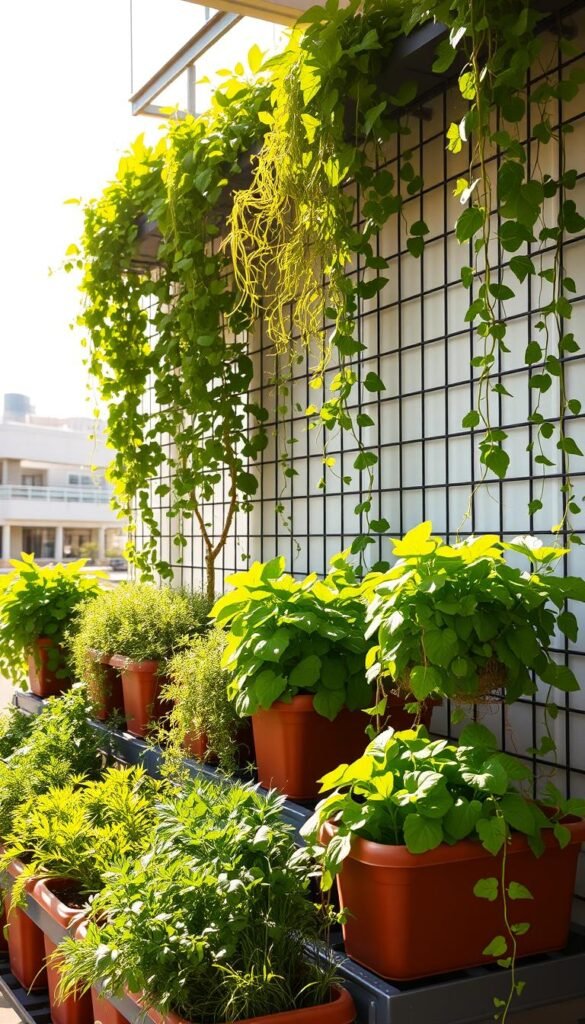Ever feel like your outdoor area doesn’t have room for lush greenery? Think again. With clever arrangements that grow upward instead of outward, you can turn blank walls, balconies, or patios into thriving green zones. This approach lets you work with what you have while adding life to overlooked corners.
Leading experts like Gardenesque showcase how hanging baskets and wall-mounted pots create instant visual impact. Fine Gardening magazine highlights tiered shelves that let herbs and flowers climb naturally. These methods aren’t just pretty – they keep pathways clear and make watering simpler.
Why does this style work so well? Structured layouts help plants get more sunlight while preventing overcrowding. You’ll also discover creative ways to repurpose items like old ladders or pallets as plant stands. Later sections will walk you through building these systems step-by-step.
Key Takeaways
- Use walls and vertical structures to grow more in limited areas
- Combine functional watering systems with decorative displays
- Adapt shelving units or recycled materials for plant staging
- Improve air circulation through strategic placement
- Prepare for low-maintenance care with smart design choices
Creative Container Solutions for Compact Gardens
Even the coziest corners can burst with life using clever planting strategies. The secret? Think beyond traditional setups and experiment with multi-level designs that turn limitations into opportunities. “Every inch counts when you layer your greenery,” notes Gardenesque’s lead designer, highlighting how vertical arrangements solve space puzzles.
Tiered Shelving for Organized Growth
Three-tier shelves let you showcase trailing ivy, aromatic herbs, and colorful blooms in one spot. Opt for materials like powder-coated metal or weatherproof bamboo to match your style. Pro tip: Place taller pots on bottom shelves and petite planters up top to prevent shading.
Hanging Planters for Elevated Design
Suspend lightweight pots from ceilings or railings to create floating gardens. Macramé holders add boho charm, while geometric planters offer modern flair. A recent Fine Gardening study found hanging systems reduce pest issues by 40% compared to ground-level planting.
Mix circular and angular shapes in your layout to guide the eye upward. Group plants with similar light needs on shared shelves, and rotate pots weekly for even sun exposure. These hacks transform cramped areas into curated displays that feel intentional, not crowded.
Maximize Small Spaces: Vertical Container Gardening Hacks
Transform blank walls into living art with stacked greenery. Multi-level designs let you mix textures and colors while keeping pathways clear. Quality soil matters most here – lightweight blends prevent structural stress and nourish roots in tight spaces.
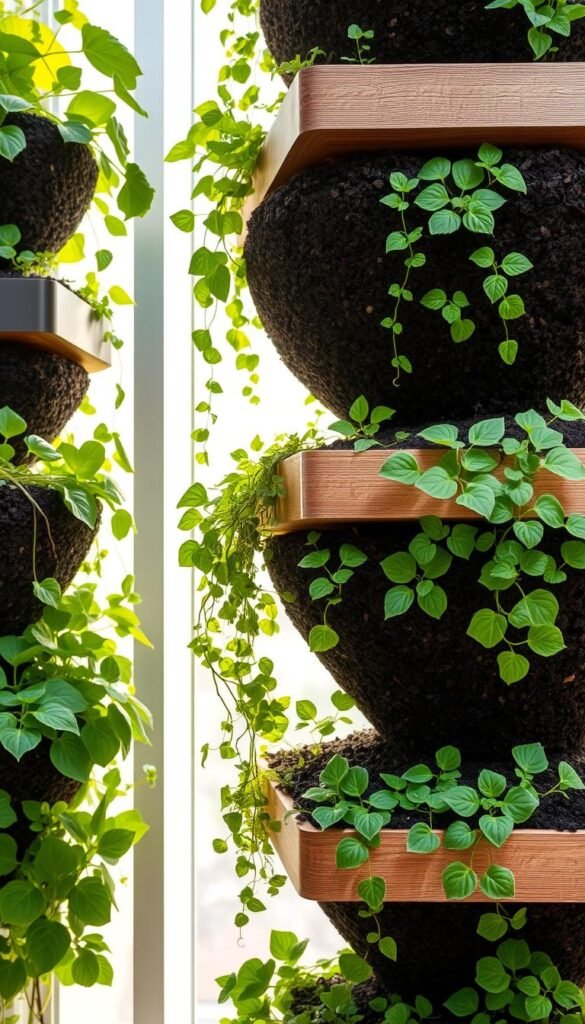
Vertical Plant Towers for Dynamic Displays
Modular towers let strawberries, succulents, and herbs grow shoulder-to-shoulder. A recent case study showed these systems yield 30% more basil than traditional pots. Use self-watering planters to reduce daily upkeep.
| System Type | Best Plants | Soil Depth |
|---|---|---|
| Hanging Towers | Trailing Petunias | 6-8 inches |
| Stackable Planters | Leafy Greens | 4-6 inches |
| Wall Grids | Air Plants | 2-3 inches |
Freestanding Trellises and Wall-Mounted Systems
Freestanding units work well on balconies, while wall systems maximize patio walls. Metal trellises support climbing beans, and woven baskets add rustic charm. Test different containers – ceramic pots retain moisture, while fabric ones improve airflow.
Integrated Drip Irrigation Systems
Timed drip lines deliver water directly to roots, cutting waste by 50%. Pair them with moisture-control soil to prevent overwatering. One urban gardener reported harvesting tomatoes weekly after switching to this setup.
Rotate planters seasonally – swap spring pansies for fall kale. Your wall garden becomes a changing canvas that’s equal parts functional and eye-catching.
Space-Saving Tips for Herbs, Vegetables, and Blossoms
Your kitchen window could be the next hotspot for fresh basil and cherry tomatoes. Compact setups let you grow ingredients and ornamentals side-by-side without sacrificing style. Start by identifying sunlit areas – even narrow ledges work when paired with smart containers.

Compact Herb Gardens in Action
Arrange rosemary, thyme, and mint in shallow pots along sunny windowsills. A Gardenesque trial showed herbs grown this way yield 25% more leaves than ground-planted varieties. Use hanging baskets for trailing varieties like oregano – they’ll cascade downward while catching afternoon light.
Window Box Micro-Gardening Techniques
Mount window boxes outside to create edible displays. Mix lettuce varieties with pansies for color contrast. Leave 4-6 inches between plants to prevent overcrowding. Rotate boxes weekly so all sides receive equal sunlight.
Watering tip: Stick your finger 1 inch into the soil – if it’s dry, give plants a drink. Pair this method with moisture-wicking liners to reduce daily upkeep. You’ll transform overlooked areas into productive zones that thrive year-round.
Innovative Upcycling and Pallet Planters
What if your garden could tell a story through reclaimed materials? Breathing new life into discarded items isn’t just eco-conscious—it’s a game-changer for crafting one-of-a-kind growing spaces. Old wooden crates become herb havens, while retired gutters transform into strawberry alleys, proving sustainability and style go hand-in-hand.
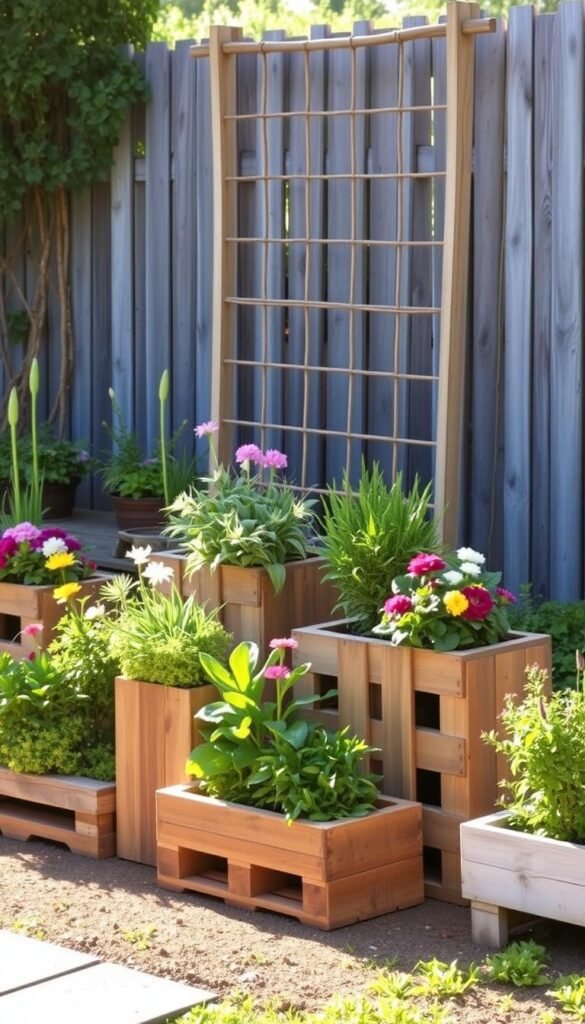
Repurposing Materials for Unique Containers
Wooden pallets steal the spotlight here. Lean one against a wall, add landscape fabric to the slats, and fill with soil for instant vertical herb pockets. A 2023 Gardeners’ World study found basil grown in upcycled pallets had 20% higher oil content than store-bought plants—talk about flavor!
Got old colanders or toolboxes? Drill drainage holes and plant mint or cherry tomatoes. These quirky pots add personality to patios and balconies. Pair them with trailing nasturtiums to soften edges and attract pollinators.
For tight areas, stack vintage suitcases or paint mismatched tin cans. Arrange them like stairs along a wall to create depth. Herbs like chives and parsley thrive in shallow containers, while deeper bins handle carrots and radishes. Rotate planters weekly so veggies get even sun exposure.
Pro tip: Use chalkboard paint on crates to label crops. This smart way to organize saves space and adds farmhouse charm. Your garden becomes a conversation starter that’s as functional as it is Instagram-worthy.
Smart Maintenance and Structural Enhancements for Vertical Gardens
Keeping your vertical garden thriving requires more than just initial setup—it demands smart care. Regular attention to watering, pruning, and layout adjustments ensures plants stay healthy while maintaining visual appeal. Let’s explore how to balance practicality with design.
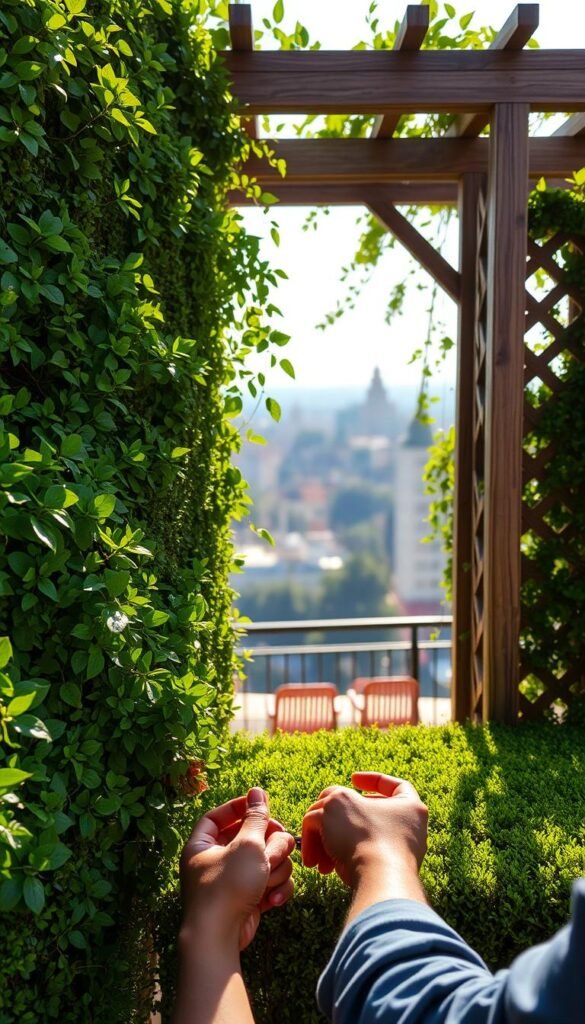
Consistent Watering and Drainage Techniques
Plants in elevated setups dry out faster than ground-level ones. Water early morning or late afternoon to reduce evaporation. Check soil moisture daily—stick your finger an inch deep. If dry, hydrate until water flows through drainage holes.
Use pots with multiple drainage points to prevent root rot. Pair them with saucers to protect your area from water stains. A recent study found container gardens with proper drainage yield 35% more blooms than poorly ventilated ones.
| Drainage Material | Best For | Watering Frequency |
|---|---|---|
| Perlite Mix | Succulents | Every 10 days |
| Gravel Layer | Herbs | Every 3 days |
| Coconut Coir | Leafy Greens | Every 5 days |
Pruning and Pest Control Best Practices
Trim overgrown leaves weekly to improve air circulation. Remove yellowing foliage promptly—it attracts pests. For aphids or mites, spray a mix of water and neem oil every 7 days. This natural solution keeps plants safe for kitchens or play areas.
Enhancing Structural Depth with Containers
Vary planter sizes and heights to create visual layers. Place tall, narrow pots behind rounded ones to add dimension. Rotate containers monthly so each spot gets equal light exposure. This technique prevents leggy growth while making your garden look fuller.
Choose textured materials like woven baskets or ribbed ceramics to break monotony. A Gardenesque survey showed varied containers increase perceived space by 40%. Your vertical setup becomes both functional and gallery-worthy.
Personalizing Your Green Haven in Daily Life
What if your garden became your favorite room? Blend leafy textures with comfy seating to craft a space that fuels your creativity and recharges your spirit. Start by carving out zones – a reading nook under a flowering trellis or a conversation corner beside cascading herbs.
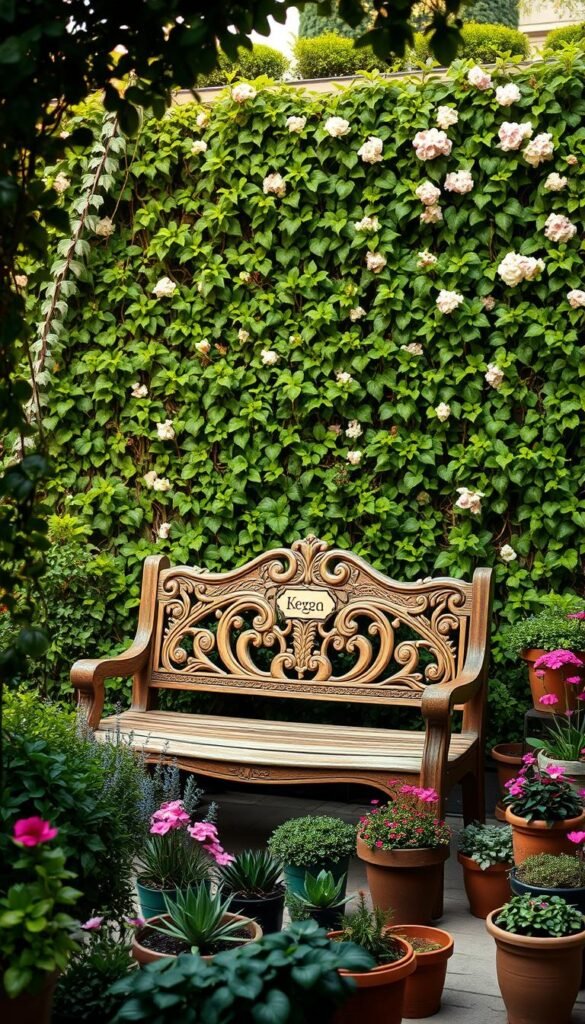
Curating Inviting Social Spaces
Swap basic chairs for a built-in bench with hidden storage. Add weatherproof cushions in patterns that mirror your indoor decor. One urban gardener transformed a 4-foot balcony into a coffee spot using foldable stools and a side table made from repurposed shutters.
String solar-powered lights through overhead planters to cast soft glows at night. Position mirrors behind greenery to amplify natural light and create depth. These touches make compact gardens feel expansive yet intimate.
Mix materials for visual intrigue – pair metal stools with woven planters, or stone coasters with wooden shelves. A recent survey found 68% of gardeners feel more relaxed in spaces that combine living plants with functional furniture. Your design becomes a sanctuary that celebrates both life and personal style.
Leave room for spontaneity. Let mint spill onto a side table, or train jasmine around chair legs. These organic details turn structured layouts into living, breathing retreats that evolve with your daily rhythm.
Conclusion
Ready to reimagine your outdoor space? By layering herbs, flowers, and veggies upward, you craft lush displays that defy square footage limits. Repurposed pallets become living walls, while smart watering systems keep roots thriving without daily fuss.
Start by choosing sun-loving plants for your home’s unique conditions. Mix edible greens with vibrant blooms in stacked planters – basil pairs beautifully with petunias. Rotate pots weekly to ensure even growth, and use drip lines to conserve water during hot months.
Add personality through unexpected ideas: paint old toolboxes as herb homes or train ivy around salvaged ladders. These touches turn functional setups into artistic statements. Remember, healthy gardens need airflow – prune dense foliage and prioritize containers with drainage holes.
Your journey doesn’t end here. Swap seasonal flowers, experiment with hanging strawberry towers, or host friends in your new green nook. With these tips, even fire escapes become thriving ecosystems. Grab those gloves – your sky-high oasis awaits.

